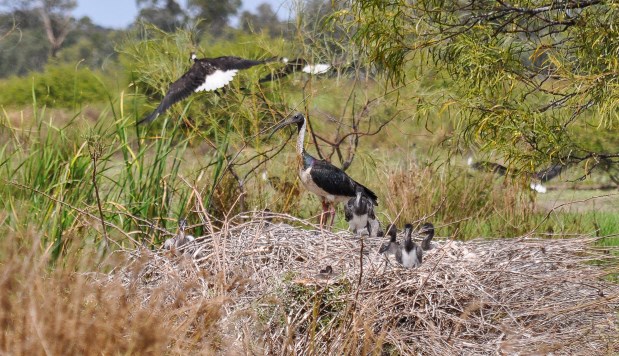Why are these places important?
Waterbirds are found in just about every wet place in our region, the numerous waterways, lakes and wetlands that dot our rivers and floodplain landscapes. They rely heavily on our inland waterways and wet areas for their food, habitat and breeding sites. The loss of habitat, lack of water flows and feral animals are serious threats to their long term survival. The wetlands and floodplain of our region are also significant to the local Aboriginal people, as their heritage and a place of important cultural sites.
In the areas where flood waters are contained, permanent and ephemeral wetlands have naturally developed over a long period of time. When rain, water and our rivers are flowing, conditions may be right for many waterbirds species to feed and nest in our important wetlands. Large scale floods are particularly important as a main trigger to attract many species of waterbirds en masse to gather and breed in our wetlands. However, dams and river regulation of our major rivers has reduced the size and frequency of natural flooding across the Murray Darling Basin, so it is important that when breeding does occur, enough water is provided for our waterbirds to successfully complete their breeding cycle.

Source: Daryl Albertson/OEH
The sites that waterbirds choose to nest are often in the lowest areas of the landscape, where water is held for longer periods, mostly along rivers their floodplains and wetlands. They contain water-loving plants and animals that in turn, provide the resources that are needed to support large scale waterbird breeding, often referred to as breeding colonies. Breeding waterbirds will therefore take full advantage of a flooded landscape as it provides both protected nesting sites and large amounts of food they need for their hungry and growing chicks.
Colonially-nesting waterbirds like ibis, egrets and herons to name a few, can congregate in many thousands to breed in small areas of wetlands. Across the Murray-Darling Basin, the Gwydir Wetlands are ranked second only to the Narran Lakes (near Walgett) for their importance to these waterbirds, followed by the Macquarie Marshes and the Booligal Wetlands on the Lower Lachlan floodplain. Successful large-scale breeding events are also a good indicator that our wetlands are able to provide both the habitat and food resources needed to support the waterbird breeding when they do occur in these systems. These habitats must therefore be protected and provided with regular water flows, to be in a healthy condition and continue to provide the food and nesting places needed for all of our regions waterbirds.
Source: Daryl Albertson/OEH
The mapping function of Waterbird Tracker provides the location of many of our important wetlands across our region. By taking part in this community waterbird tracker project, over time, the movement and locations of waterbirds will be better known across the northern region of the Murray-Darling Basin.